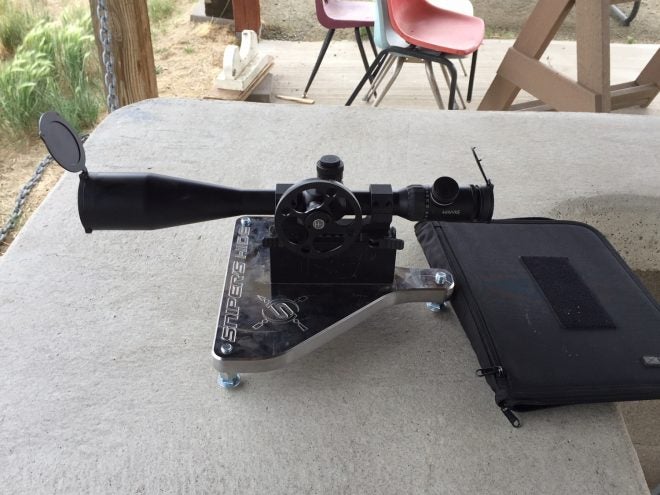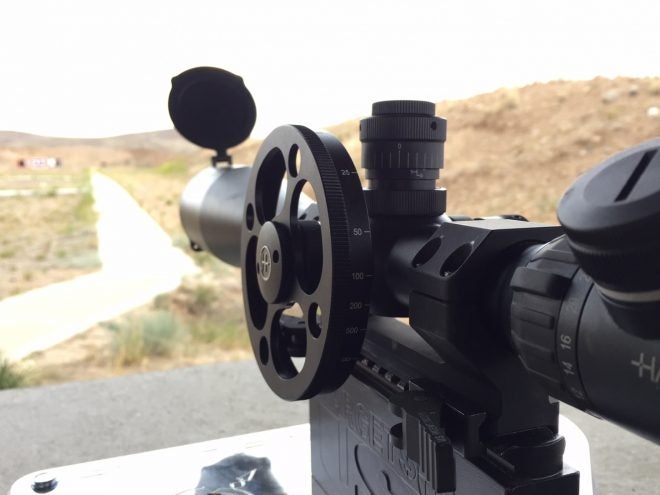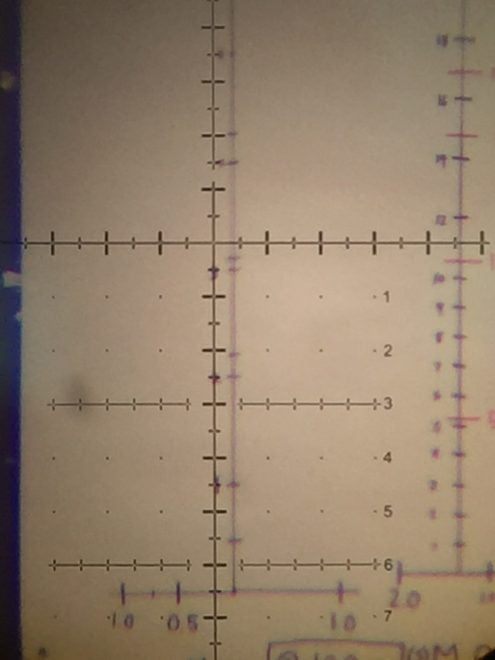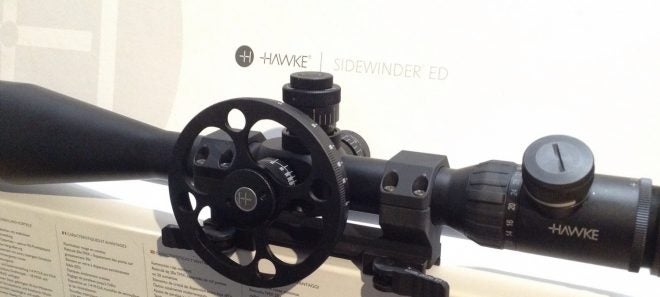In the interest of full disclosure, I have to start by saying I am not a bench rest shooter. The best 5 shot group I have ever fired measured in at .18 of an inch, which for me was outstanding. I have since punched some holes pretty close to (or overlapping to be more precise) each other but nothing to top that. Now, to most shooters, this would be more than satisfactory and something of a once in a lifetime experience, but to a certain crowd unless I was able to average that group size over 5 groups of 5 rounds each I am not even going to raise an eyebrow. In fact last year the winner of the 2017 International Benchrest Shooters Heavy Varmint Group division shot an aggregate (average of 5 x 5 round groups) of .1518. Yes, that is correct he essentially shot 5 groups equal to or better than my personal best back to back to back to back to back.

An example of what bench rest shooters aspire to. This five shot group fired at 100 yards measured in the .07’s
At the risk of offending some people, I am not a benchrest shooter for a reason. I find their reloading practices tedious, their equipment impractical and the format of their competition virtually irrelevant to real-world applications. I much prefer the scenario based shooting stages offered by the Precision Rifle Series, National Rifle League, Guardian Long Range, and Competition Dynamics. These events involve locating and sometimes ranging/doping targets, dealing with natural or manmade features and building a position all while on the clock. In my mind, this type of shooting is much more applicable to real-world situations a rifleman might encounter, but if I were physically unable to compete in these types of matches or I was simply more interested in how much precision I could mechanically ring out of a rifle then benchrest would be the game for me.
As you would imagine getting the utmost precision out of a rifle is an expensive proposition. Custom actions regularly sell for over $1200, a barrel will cost over $600 installed and a stock bedded to the rifle can easily be upwards of $700. That is not even taking into account the price of all of the reloading equipment needed to make near perfect ammo; scales, powder tricklers, presses, dies, neck turning tools, etc. These high costs can be a barrier to entry for some. Fortunately, like most things, there are good budget-friendly options available to the informed consumer. There are very high quality used rifles on market for under $2,000, and although the top of the line reloading gear will yield good results, with less effort, people have been able to achieve outstanding groups with the combination of rudimentary tools but meticulous procedures. The final item I have not mentioned until now is the optic.
Suitable optics range anywhere from $1,000 to $4,000. With an MSRP of $999.99 the Hawke SIDEWINDER ED 10-50×60 TMX comes in at the bottom end of that price range, but does it still have the features to compete with the higher priced scopes on the firing line? I took a hard look at it and this is what I found.

Scope tracking rig
Features
For what I would consider a budget scope in this category the Hawke Sidewinder ED 10-50×60 is feature rich. Here is what they have listed on their website (https://us.hawkeoptics.com/sidewinder-ed-10-50×60-tmx.html):
- Extra-low Dispersion (ED) glass for optimum clarity.
- Interchangeable, locking and resettable turrets. (1⁄4 MOA, 1⁄8 MOA & 1⁄10 MRAD supplied)
- Side focus control for parallax adjustment to infinity.
- 30mm mono-tube chassis for superior strength.
- Glass etched reticle with red illumination.
- Stepless IR rheostat offers total brightness control.
- Locking ocular and high torque zoom ring.
- Includes screw-in metal flip-up lens covers.
I would like elaborate on the merits of a few of these items.
Glass quality
I found the clarity and sharpness of this optic to be on par with most other scopes in its price range. I did appreciate the high-end magnification range because while the image started to get a little “milky” up near the top end (45-50x) it was still crisp at 40x, which is still a lot of magnification.
Turrets:
It was a novelty to have the various turrets(.1 mil, ¼ MOA, ⅛ MOA), but I preferred the ⅛ MOA turrets as they allowed me the finest adjustment. This made it so I could have a perfect zero vs being slightly offset due to the coarseness of my turrets. I did perform the typical box tracking test with this scope and it tracked and returned to zero within the mechanical accuracy of my rifle. Also worth noting it held zero perfectly throughout various trips to the range.

User interchangeable turrets.
Parallax adjustment:
This was probably the one feature I was most curious about. When I first saw the extra large parallax wheel I thought it seemed a little gimmicky, but the more I used it the more I realized how valuable it is. To illustrate this I will have to reiterate the intended use for this scope, benchrest shooting. In this discipline, time is not a factor as much as making perfectly aimed shots, so the shooter has the time to dial out all of the parallax. Parallax is an optical phenomenon that occurs in rifle scopes because the shooter is trying to line up three points (shooters eye, reticle, and target). In my experience parallax error can occur even if the target appears to be in focus. This can account for at least ¼ MOA deviation on target if parallax is not removed, which for a benchrest shooter could mean the difference between a top finish and middle of the pack. The large wheel allowed me to make very precise incremental adjustments to the parallax viewed in the scope. The last key feature to the parallax adjustment on this scope is its ability to focus as near as 10 yards, which makes it suitable for small bore shooting.

Notice the large parallax wheel allowing for fine adjustment.
Reticle
The reticle in my test scope is what Hawke calls their TMX reticle. It is milliradian based with both elevation and wind hold offs. Since the scope is second focal plane the subtensions in the reticle are only correct at one magnification setting. Hawke states this is at 20x. I found this statement to be accurate when viewing it against my calibration board (there is a number 20 on the zoom ring to reference). Having the reticle subtend correctly at the lower end of the magnification range is somewhat unique, most manufacturers will have the subtensions be correct at or near max power since it correct at 20x it does afford another neat option though, which is to run the scope at 40x and read the reticle at half value. The last feature of the reticle I appreciated was the open center. Many people like a floating center dot for a fine point of aim, however, a center dot that is .05 milliradians will cover .18 of an inch at 100 yards which is the majority of a bullet hole. Using this scope at 45 or 50 power the open center allows you to place the gap in the crosshairs right in the center of the last hole.

The photo was taken through the scope with phone showing reticle subtensions
Other Niceties
The aluminum lens caps are a nice touch. They are very robust and seem like they would be far less prone to breaking as compared to their plastic counterparts. I did not find any need for the red illuminated reticle but having it on a rheostat fit the theme of fine adjustments. Finally, while I do not like to judge a book by its cover, the packaging the scope arrived in was top notch with a very high-density foam which really seemed to protect the scope well and give it a classy feel upon opening the box.

Nice Presentation
Conclusion
While this scope is not going to dethrone scopes like March or Nightforce at the top of the benchrest table, it does offer a comprehensive feature set with some interesting design elements at a very reasonable price. For a shooter new to benchrest shooting looking to get in at a budget-friendly price point or someone looking for an affordable option for their precision rimfire rifle the Hawke Sidewinder ED 10-50×60 has a lot to offer.
 Your Privacy Choices
Your Privacy Choices
